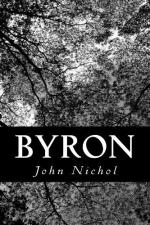Shelley took his leave, after a visit of ten days’ duration, about the 17th or 18th of April. In a letter, dated August 26, he mentions having secured for his lordship the Palazzo Lanfranchi, an old spacious building on the Lung’ Arno, once the family residence of the destroyers of Ugolino, and still said to be haunted by their ghosts. Towards the close of October, he says they have been expecting him any day those six weeks. Byron, however, did not leave till the morning of the 29th. On his road, there occurred at Imola the accidental meeting with Lord Clare. Clare—who on this occasion merely crossed his friend’s path on his way to Rome—at a later date came on purpose from Geneva before returning to England to visit the poet, who, then at Leghorn, recorded in a letter to Moore his sense of this proof of old affection undecayed. At Bologna—his next stage—he met Rogers by appointment, and the latter has preserved his memory of the event in well-known lines. Together they revisited Florence and its galleries, where they were distracted by the crowds of sight-seeing visitors. Byron must have reached Pisa not later than the 2nd of November (1821), for his first letter from there bears the date of the 3rd.
The later months of the poet’s life at Ravenna were marked by intense literary activity. Over a great part of the year was spread the controversy with Bowles about Pope, i.e. between the extremes of Art against Nature, and Nature against Art. It was a controversy for the most part free from personal animus, and on Byron’s part the genuine expression of a reaction against a reaction. To this year belong the greater number of the poet’s Historical Dramas. What was said of these, at the time by Jeffrey, Heber, and others, was said with justice; it is seldom that the criticism of our day finds so little to reverse in that of sixty years ago.




